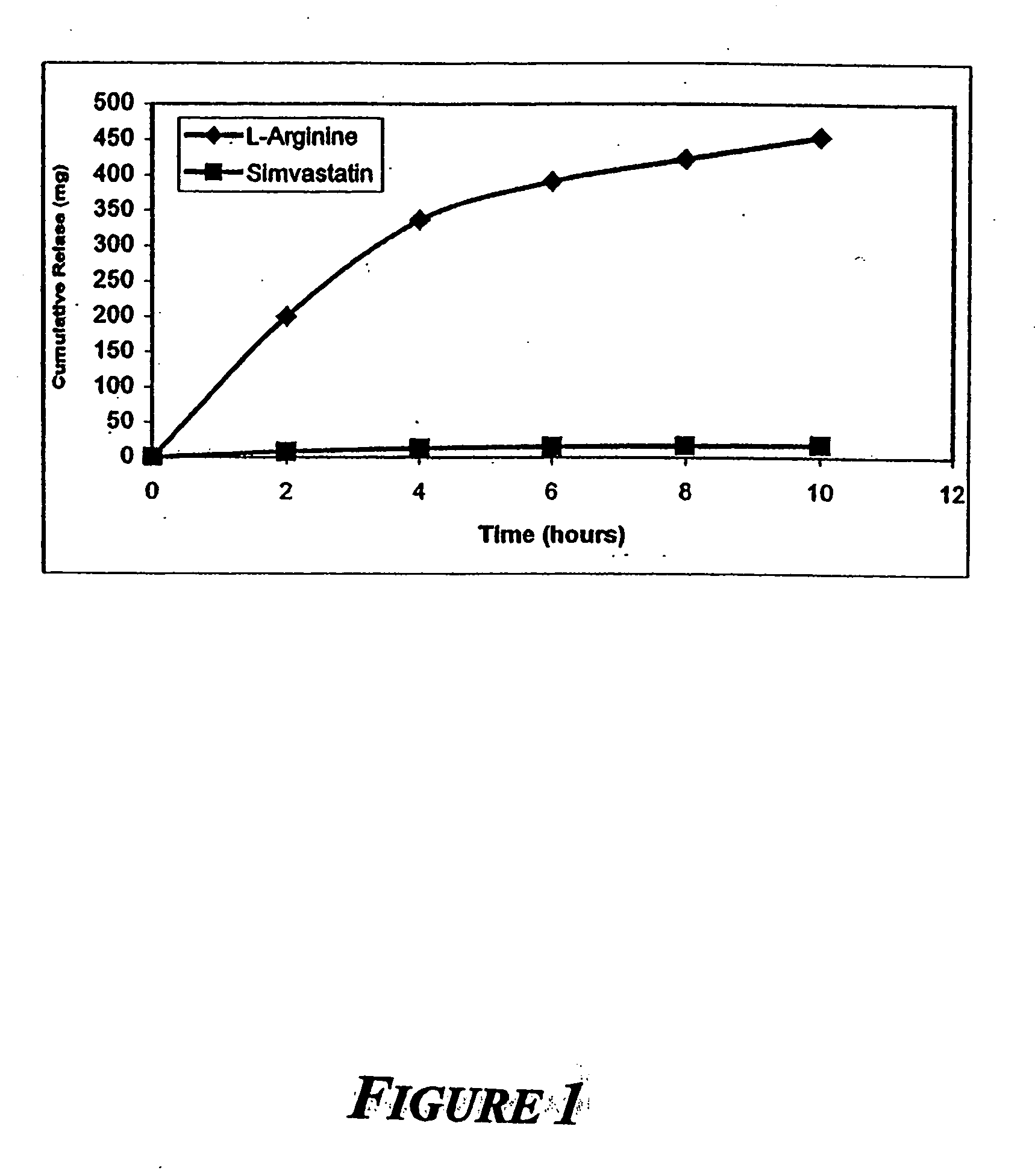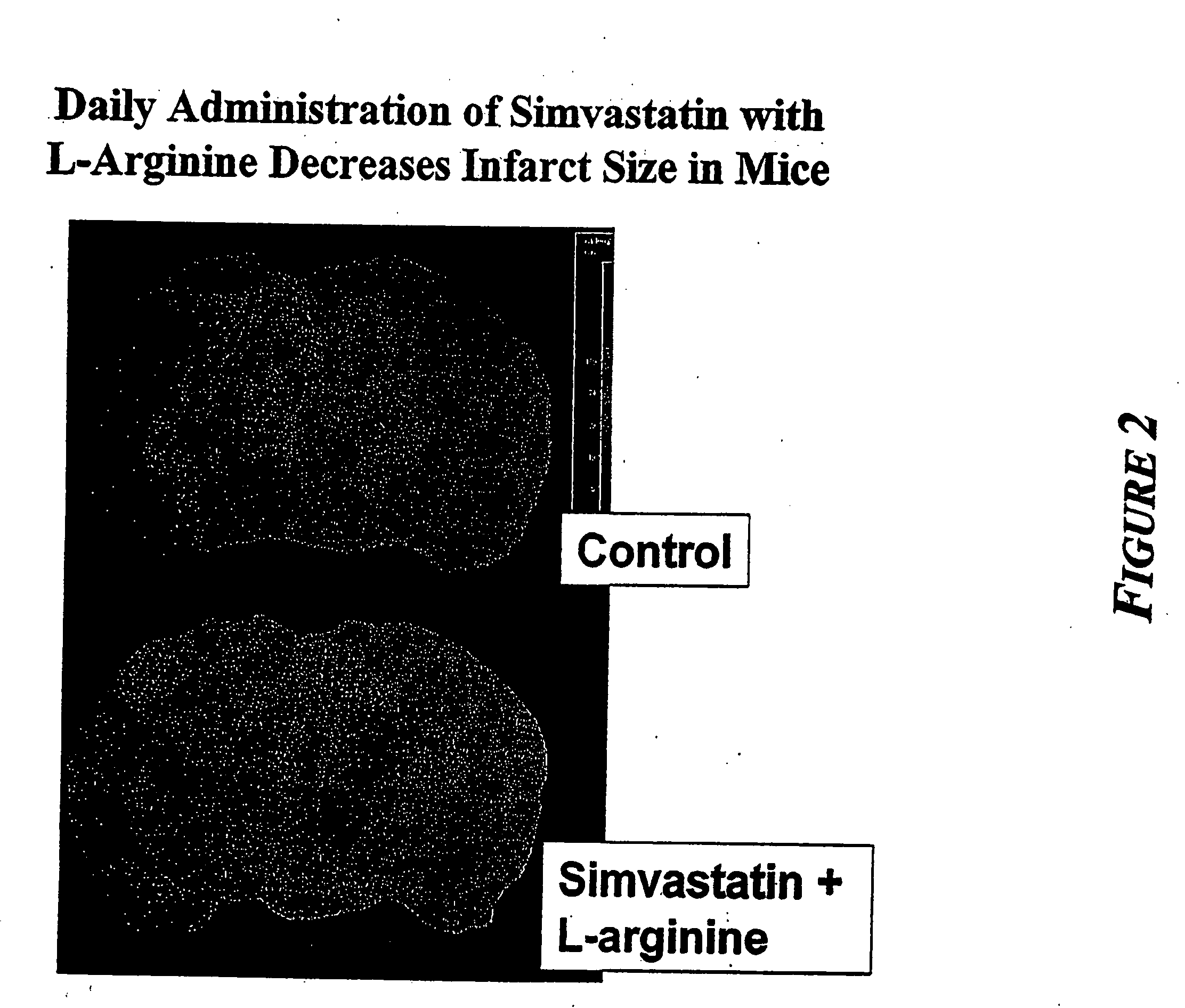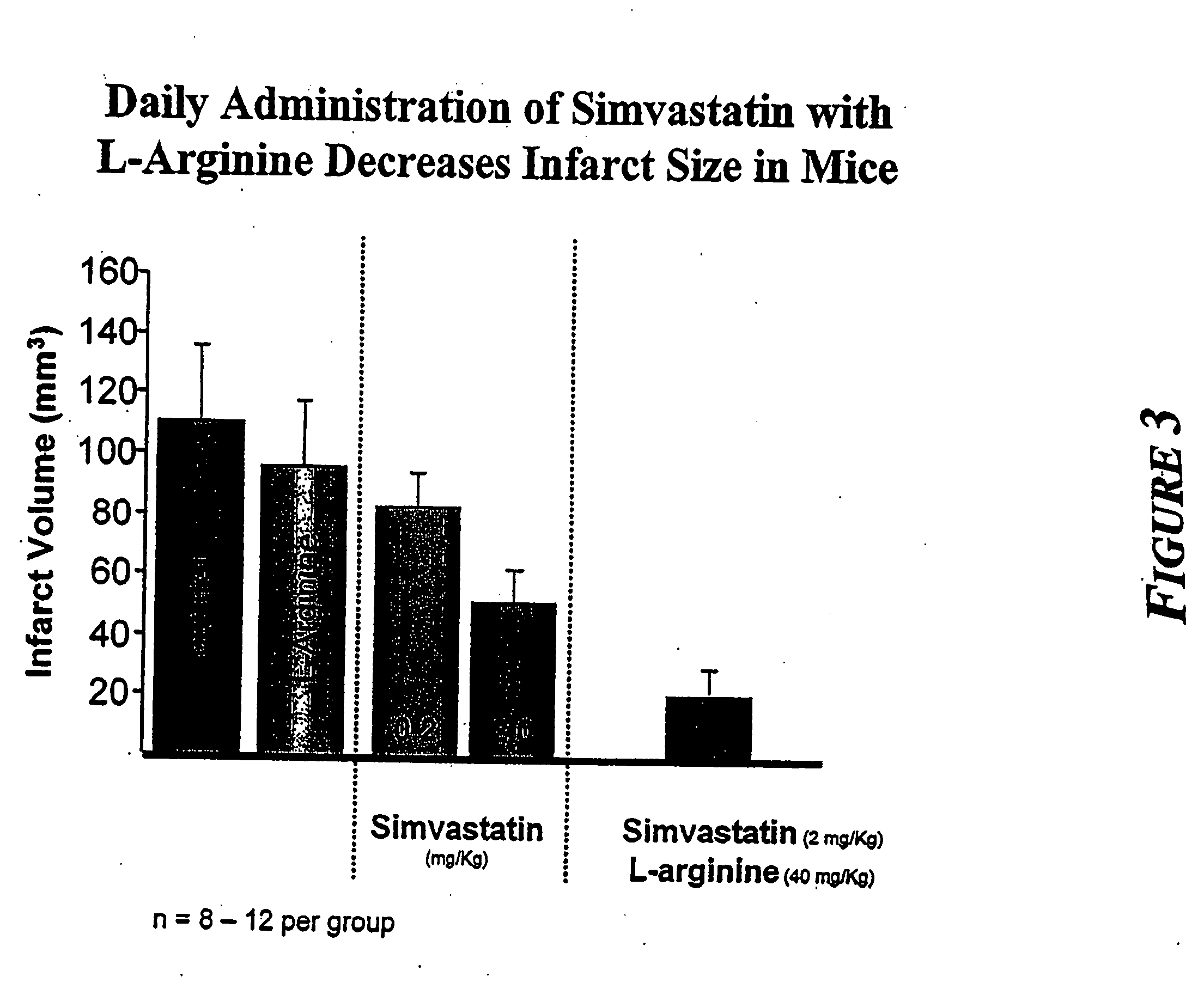[0010] The present invention provides methods for the treatment and prevention of vascular diseases and disorders including, but not limited to, cardiovascular, cerebrovascular and
peripheral vascular diseases and disorders. The present invention is based, at least in part, on the discovery that the coadministration of an HMG-CoA
reductase inhibitor and a sustained release formulation of L-
arginine has a synergistic effect in the treatment and prevention of vascular diseases and disorders, and, in particular, in lowering
cholesterol and triglycerides. Moreover, the invention provides a sustained release formulation of L-arginine and methods of manufacture that render a composition with an optimal release profile. Furthermore, the formulation and methods of manufacture render a composition that is conveniently compressible, but not excessively friable.
[0012] In another aspect, the present invention provides a method for increasing
nitric oxide production in a subject with elevated asymmetrical dimethylarginine (ADMA) by administering to the subject an HMG-CoA
reductase inhibitor and L-arginine. In yet another aspect, the present invention provides a method for increasing
vasodilation in a subject with elevated asymmetrical dimethylarginine (ADMA) by administering to the subject an HMG-CoA reductase inhibitor and L-arginine. In various embodiments of these aspects of the invention, L-arginine is present as a sustained release formulation. In other embodiments, the HMG-CoA reductase inhibitor is
simvastatin. In certain embodiments, the subject may have
endothelial dysfunction. In other embodiments of these aspects of the invention, the method increases endothelial function.
[0013] In another aspect, the present invention provides a method for increasing nitric
oxide (NO) production in a subject with elevated asymmetrical dimethylarginine (ADMA) by administering L-arginine to the subject, wherein the L-arginine overcomes the
inhibitory effect of ADMA. In yet another aspect, the present invention provides a method for increasing
vasodilation in a subject with elevated asymmetrical dimethylarginine (ADMA), by administering L-arginine to the subject, wherein the L-arginine overcomes the
inhibitory effect of ADMA. In various embodiments of these aspects of the invention, HMG-CoA reductase inhibitor (e.g.,
simvastatin) is coadministered with the L-arginine. In certain embodiments, the L-arginine is present as a sustained release formulation. In other embodiments of these aspects of the invention, the method increases endothelial function.
[0017] In another aspect, the invention provides a food bar including a sustained release formulation of L-arginine (e.g., sustained release granulars of L-arginine) for use in treating or preventing a
vascular disease or disorder. The food bar may also include an HMG-CoA reductase inhibitor (e.g.,
simvastatin). In various embodiments, the food bar lowers
cholesterol, lowers C-reactive
protein, can treat or prevent Alzheimer's
Disease, and / or can treat or prevent
intermittent claudication.
[0019] In another aspect, the invention provides a method for lowering cholesterol in a subject, including administering to a subject a sustained release formulation of L-arginine. In various embodiments, the method may
lower total cholesterol,
low density lipoprotein (LDL) cholesterol, and / or triglycerides, and / or increase
high density lipoprotein (HDL) cholesterol in the subject. In another aspect, the invention provides a method for treating or preventing Alzheimer's
disease, including administering to a subject a sustained release formulation of L-arginine. In yet another aspect, the invention provides a method for treating or preventing
intermittent claudication, including administering to a subject a sustained release formulation of L-arginine. In yet another aspect, the invention provides a method for lowering C-reactive
protein, including administering L-arginine (e.g., sustained release L-arginine) to a subject. In certain embodiments of the preceding aspects of the invention, the sustained release formulation includes about 25% to about 75% by weight of L-arginine or a pharmaceutically acceptable salt thereof; about 0.5% to about 5% by weight of
polyvinylpyrrolidone; about 5% to about 40% by weight of hydroxypropyl methylcellulose; about 2% to about 20% by weight of
microcrystalline cellulose; less than about 3% by weight of
silicon dioxide; and less than about 3% by weight of
magnesium stearate. In a particular embodiment, the sustained release formulation includes about 50% by weight of L-arginine monohydrochloride, where the L-arginine is L-arginine monohydrochloride; between about 3% and about 4% by weight of
polyvinylpyrrolidone; about 35% by weight of hydroxypropyl methylcellulose; about 10% by weight of
microcrystalline cellulose; less than about 1% by weight of
colloidal silicon dioxide, where the
silicon dioxide is
colloidal silicon dioxide; and less than about 1% by weight of
magnesium stearate.
[0020] In various other aspects, the present invention provides a method for treating or preventing a
vascular disease or disorder, a method for treating or preventing atherosclerosis, a method for increasing
vasodilation, and / or a method for increasing nitric
oxide production, including administering to a subject a sustained release formulation including about 25% to about 75% by weight of L-arginine or a pharmaceutically acceptable salt thereof; about 0.5% to about 5% by weight of
polyvinylpyrrolidone; about 5% to about 40% by weight of hydroxypropyl methylcellulose; about 2% to about 20% by weight of
microcrystalline cellulose; less than about 3% by weight of
silicon dioxide; and less than about 3% by weight of
magnesium stearate. In particular embodiments of the preceding aspects, the sustained release formulation includes about 50% by weight of L-arginine monohydrochloride, where the L-arginine is L-arginine monohydrochloride; between about 3% and about 4% by weight of polyvinylpyrrolidone; about 35% by weight of hydroxypropyl methylcellulose; about 10% by weight of
microcrystalline cellulose; less than about 1% by weight of
colloidal silicon dioxide, where the
silicon dioxide is colloidal
silicon dioxide; and less than about 1% by weight of
magnesium stearate.
 Login to View More
Login to View More 


